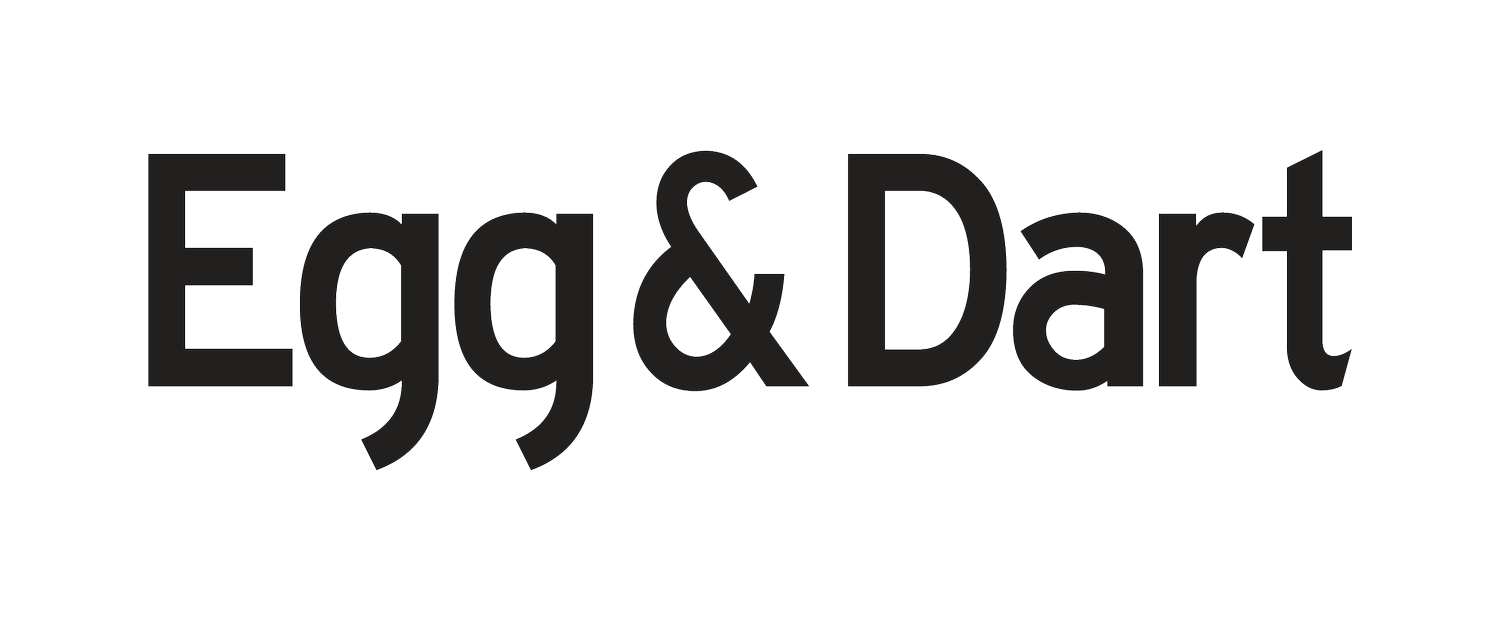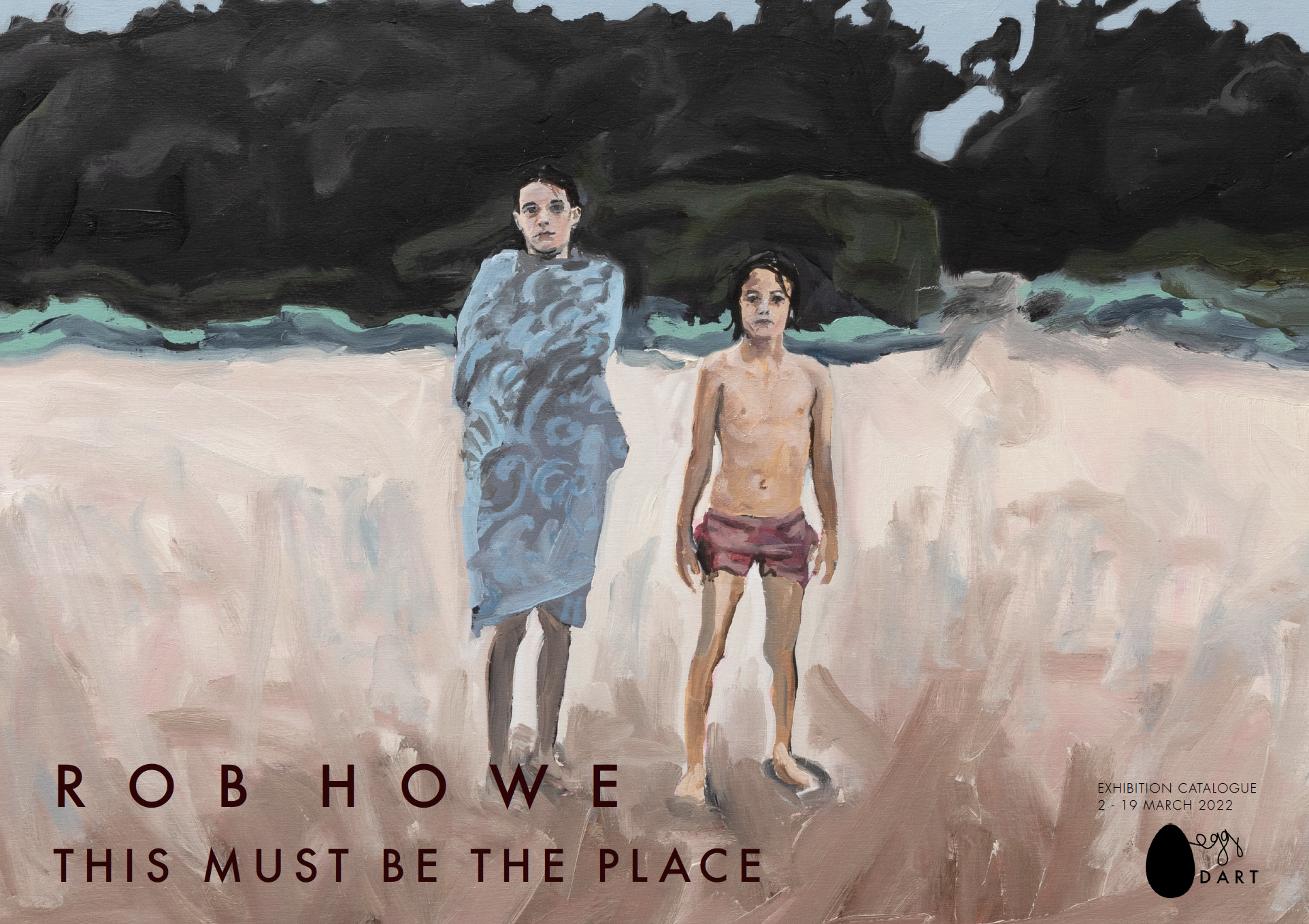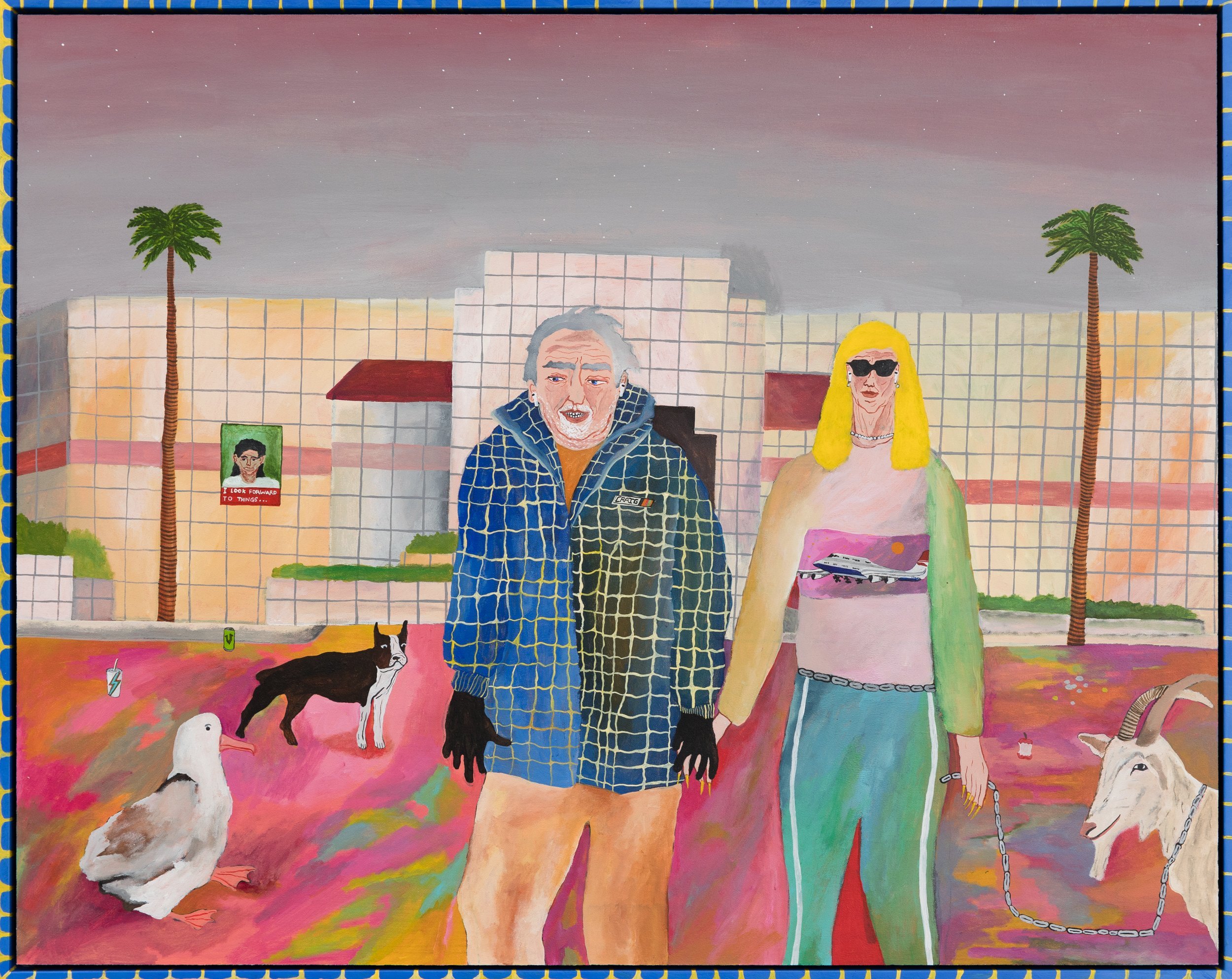
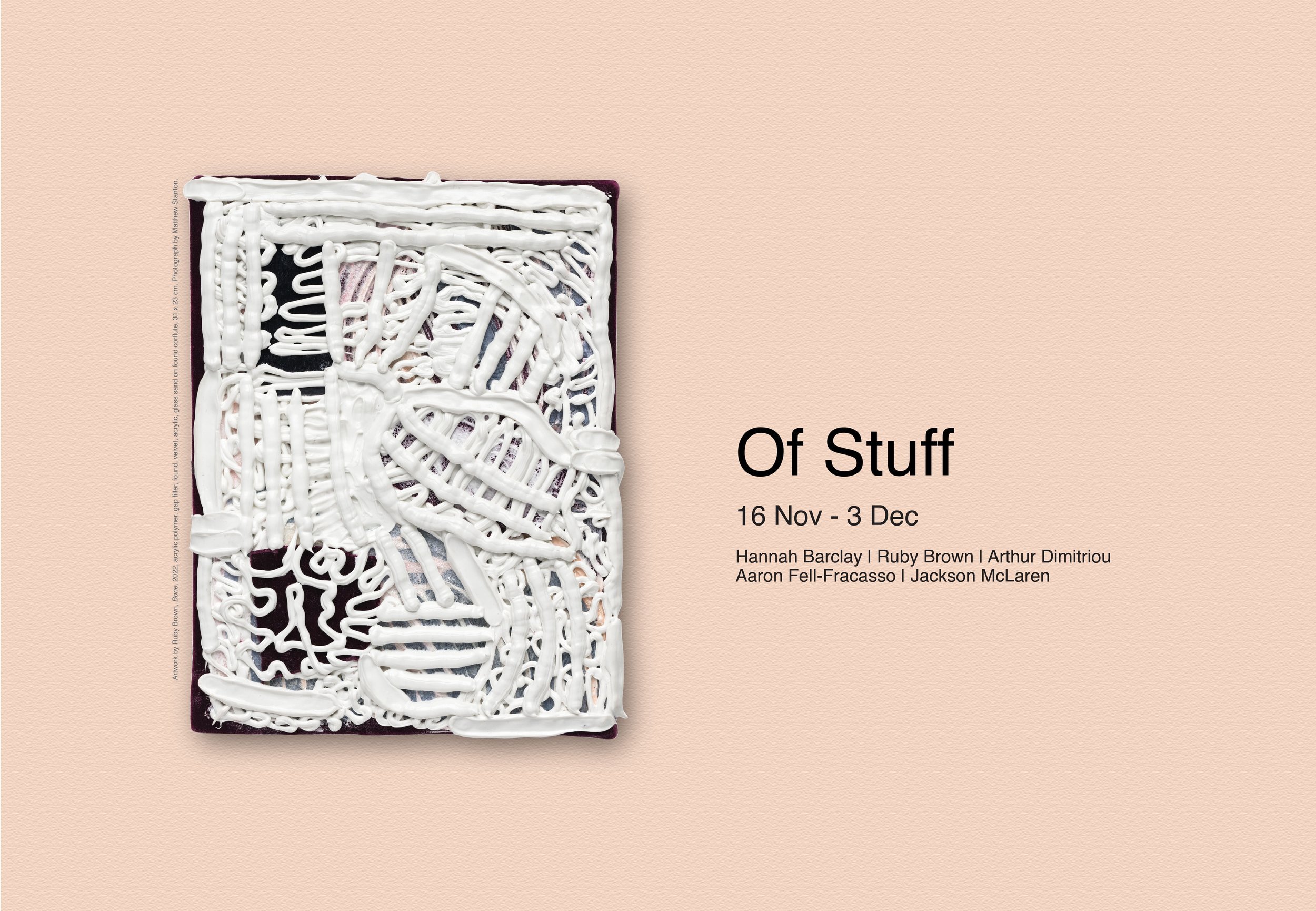
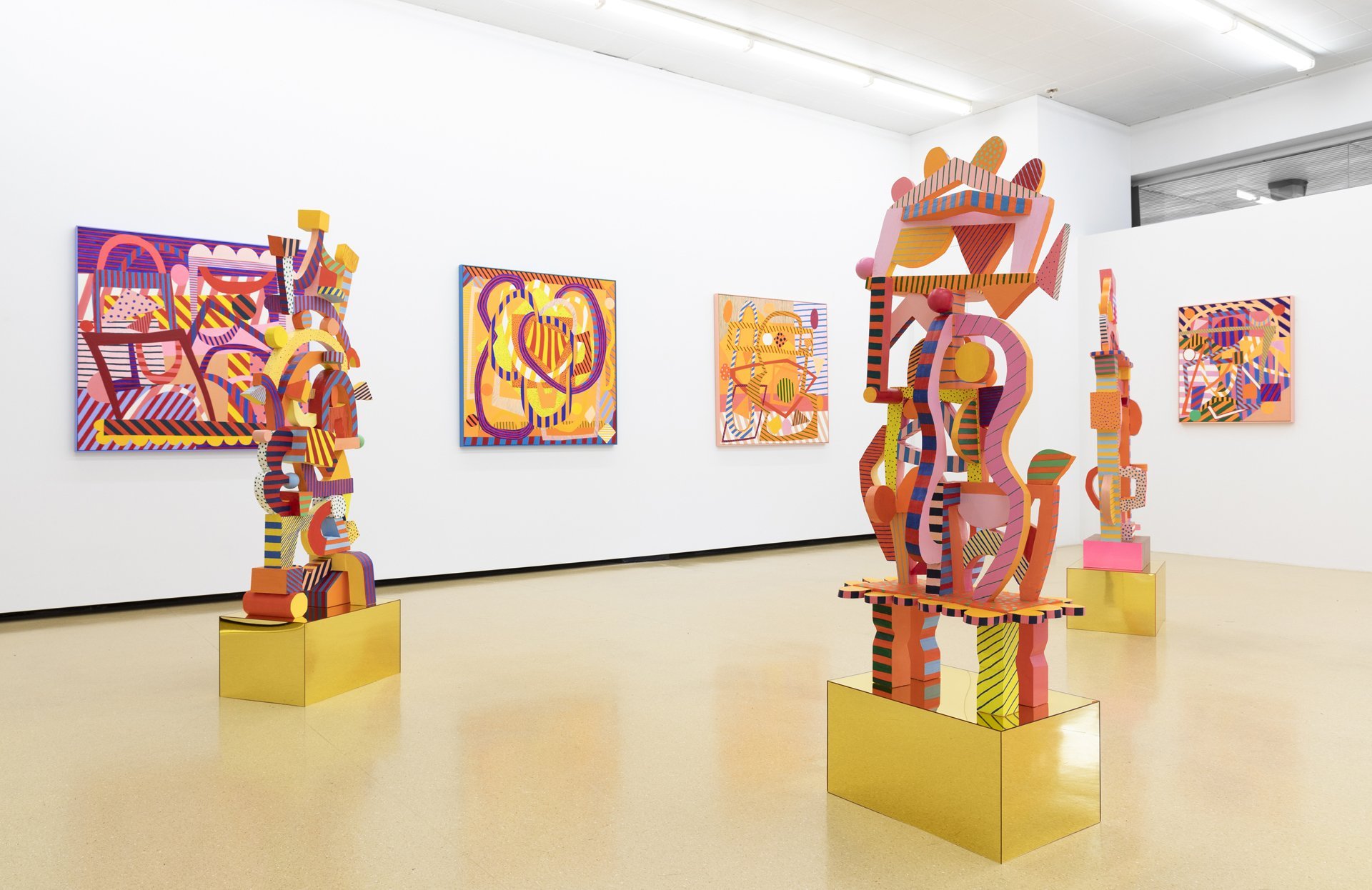
JULIA FLANAGAN | PARADISE CIRCUS
Like the looping lines that circuit her work, Julia Flanagan’s paintings and sculptures are intricately linked. Drawings may begin as plans for sculptures but then emerge as painting. Zoomed in sections of an earlier work establish a starting point for the new, before the introduction of dynamic ribbons in scintillating patterns.
The latest paintings play more intensely with all these layers. Formats based on the geometry of the quilting square (used by her mother) are a stable background. But with this anchor in place, curlicues then twist in front and around, at times weaving in and out like a needle in motion, a thread bouncing off or negotiating edges. These movements encourage us to then move similarly around the sculptures which Flanagan is now really turning up to the scale of the body. Elevated on specifically designed plinths, they address the standing figure but also speak of the hand, of construction in wood as well as in painting and drawing. The cut-out assemblages breathe into the space with their attuned negative shapes. They feel like aspects of the paintings that have been brought out into another dimension for reflection and clarity.
The Paradise Circus series started with sketches made last year while Julia Flanagan was immersed in home schooling. As she states, “That’s where these more open, layered paintings came from. I’ve done a stack of really little drawings. A painting might come from a sketch that would be half an A4, maybe smaller. They start off quite miniature mainly because I can do that quickly.”
To find shape, Flanagan looks to aspects of the everyday. To get started on drawing she might sit and look around her home studio and find forms from architecture and design that then shift through her generative drawing. One painting references a favourite chair. We might not locate the form of a chair in the final piece, but it offers a sensibility to establish a new compositional thing. Titles for work are similarly open, with references to music that connect tangentially and arise as the artist works.
In Paradise Circus there is delight and dynamism. Flanagan’s work is an extended exploration of visual pleasure but it is a tricky field that she constructs. Forces of wild linear patterns locate a joyous in-between tension, and then circle us back into the space of the body through sculptures that transcribe ovals to spheres and lines into rods and prisms.
In November 2022, Julia Flanagan is a finalist in the Fishers Ghost Prize. She won the Georges River Sculpture Prize in 2019 and has shown at Sydney Contemporary in 2020. Also in 2020, Flanagan collaborated with the Gorman (Textile and Fashion Design) brand. This is her third solo exhibition with The Egg & Dart.
Words by Melody Willis
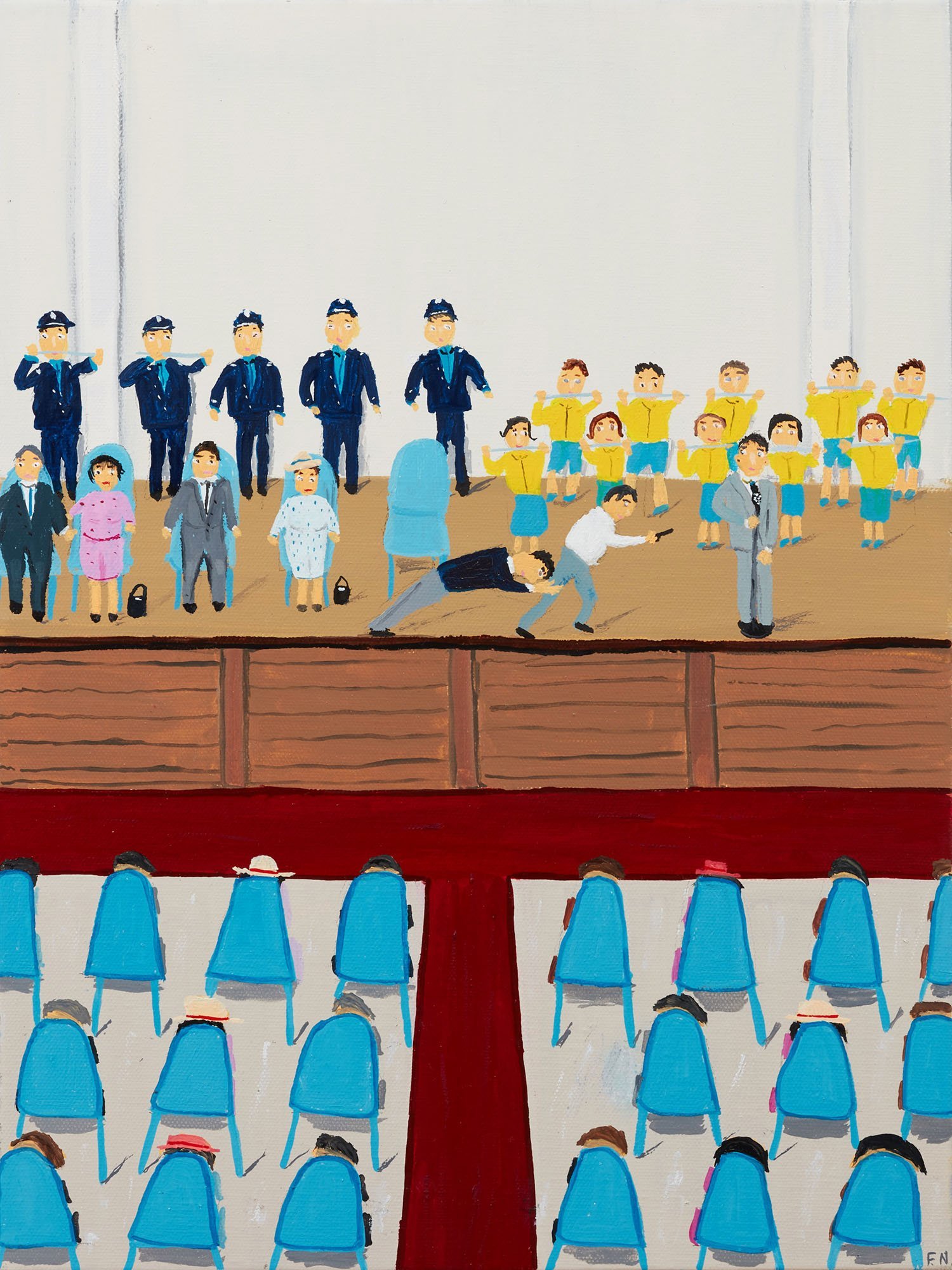
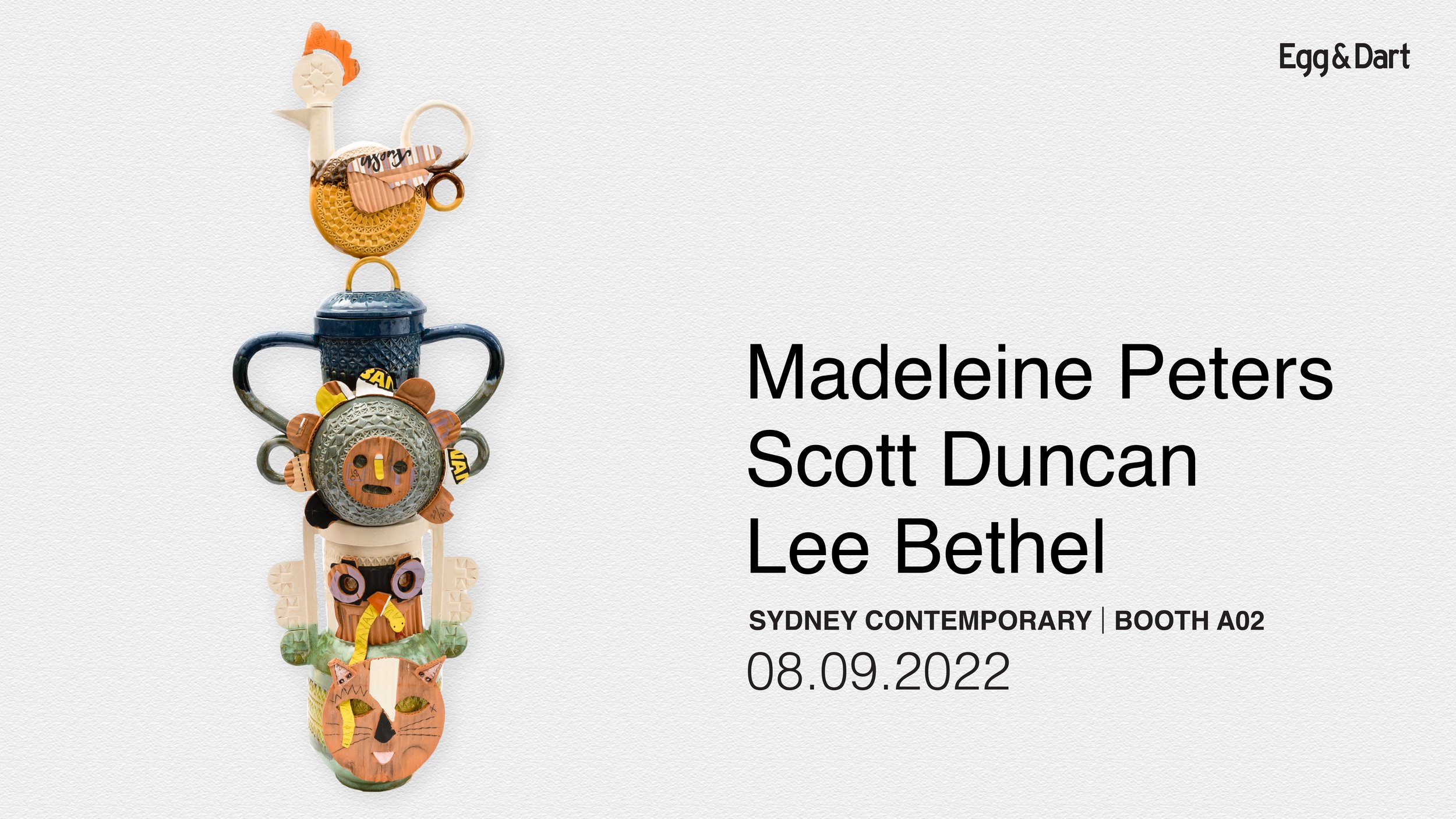
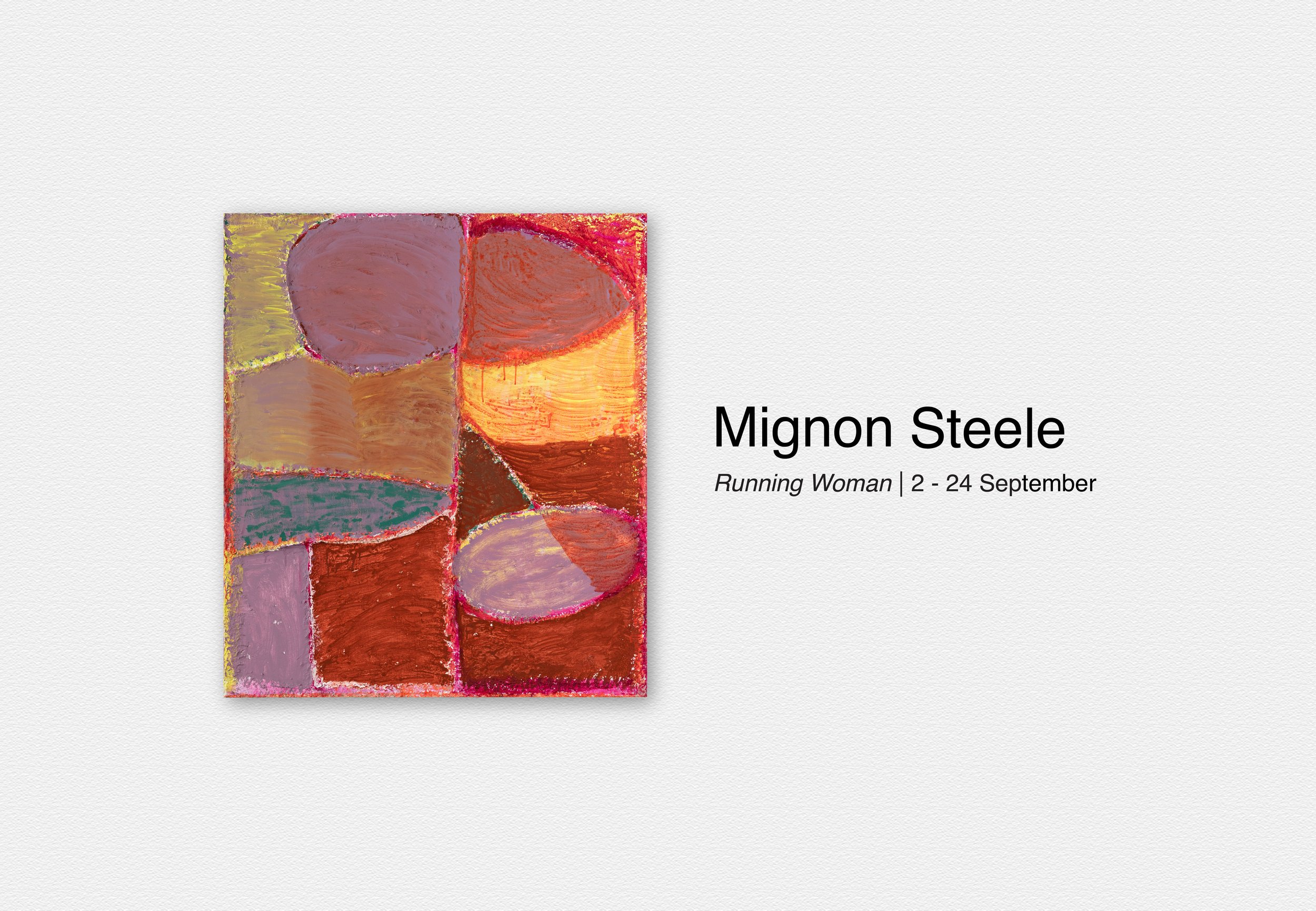
MIGNON STEELE | RUNNING WOMAN
Mignon Steele describes the shapes that emerge in her work as familiar enough to have names – banana peel, bottle, mushroom. As ways of working, these forms have hung around from earlier painting days but are boiling up again, remixed at new scales. She loops around them, shifting their depth and discernment, using them as a grounding force for new work. The shapes range – from protozoan creatures to the other end of the scale – suggesting repetitions from tiny imprints to the galactic. It’s not so much a language as it is a codex of marks and habits and ways of working that are revisited, carved out or newly summoned.
The organisation of the smaller works is described by the artist as “like little terrains, aerial worlds, models, landscapes”. Being more a feeling for landform than a mapping, Mignon Steele has built up areas with recycled yellow pages bound with wood glue. She refers to these accretions of surface as “hedges or stone walls” that push toward the sides. At times they form a sculptural frame. In other instances they are like a collection of fields, some tended, others lying fallow. It’s a kind of feeling out through painting to the edges of things, building up in parts, then pushing back down, the work eroding so that the surface is weathered to something geological. As viewers, we might fall off the edge only to discover that the sides of the paintings are also addressed, with a suggestion that the work just keeps on going, expanding and breathing through layers of colour. Opaque tints of yellow refuse to disappear under rich sepia reds shifting to magenta. Wild colour laps up against the edges of these papier maché fields, washing back to expose submerged hues beneath.
Running Woman refers to a ponytailed jogger that Mignon Steele notices when travelling between studio and home: “I see her as a kind of talisman, a spectral figure. I haven’t resolved what it means to see her yet, but I know it means something.” An inspiration, a tender touchstone, a consistency but also a metaphor, they might appear to the artist along a path, at the supermarket, or on a trail. Running woman is an emerging form in the artist’s way of working, landing somewhere between the micro-organisms and the celestial pinpoints that populate the work.
In the paintings on linen, Steele invites us to “get inside them a little more”. These larger works relate more to the scale of the body and, with a few cues (like a discernible ground plane or horizon), we can gather pictorial readings. They are initiated rapidly and have what the artist describes as a “stage-like quality” where she visits habitual forms like the blue-red mushroom or a book, banana peels and diatoms (plankton).
One large work on linen, Sitting Woman, uses that same earthy red as Running Woman but here it is pushed back by various tints of blue-green. Works like these have a direct connection to the drawing practice the artist continues in the evening and then brings to the studio. These paintings are “an extension of a language of shapes and voids and sensibilities that starts in a sketchbook and is elaborated on with paint and time.”
The eponymous Running Woman painting reminds Mignon Steele of the Marcel Duchamp glass piece, “The Bride Stripped Bare”, specifically in the way the forms stand quite upright or collage-like. In Steele’s work, the shapes are organised as an earthy mid-ground in front of blue. She joked in its casual process of making that it was “the banana stripped bare” (there’s that banana peel again). But as the work resolved itself, this informal title fell away. Humour is used as levity in a perplexing world where disaster and dilemma are prodded by human impacts. Steele describes a combination of feelings and thoughts around “nature, earth, perils and then funny stuff that cracks me up a bit”. It’s there in the titles – something lighter used as a brace but also an invitation to look further and let the works build their heavy scope in your own time as a viewer. An example, “Legless lizard”, is a gentle start that allows the work to emerge as complex over time, embedded with painterly problems, hopeful glimpses and partial resolutions.
Melody Willis



Now Showing
Join us this Friday 1 July, 6 - 8pm, for the opening of Now Showing. Featuring Gabrielle Adamik, Adrian Baiada, Lee Bethel, Amy Cuneo, Scott Duncan, Ebony Eden, Julia Flanagan, Aaron Fell-Fracasso, Rob Howe, India Mark, Mark Merrikin, Darren Munce, Frank Nowlan, Madeleine Peters, Nick Santoro, Mignon Steele, Henry Jock Walker, Christopher Zanko, Now Showing is the first exhibition at our new gallery.


Rob Howe
When I ask Rob Howe what he has been looking at I expect painters but he instead recommends poets and musicians. He describes his own paintings as romantic (like a pop song might be), pointing to the Talking Heads track referred to in the show title, This Must Be the Place. The new collection of paintings does echo some unexpected shifts in circumstance and domestic responsibility. Viewed as a collection, there is a sense of an artist re-defining what home is through uncertainty and inquiry, having moved with family to around ten different places over the time the works were made. Rob Howe says,
“(These) are sacred places that have been stolen and occupied. I often think about that as I work and play in it ... share the same place for a minute or two. I don't know all of what has gone on here, and as a white fella I'm often not exactly sure of my place. I need to listen more to find out. So, this is a modest attempt at listening by looking.”
A new colour language has emerged. From a base of phthalo and white there is a modulated, green-tinged blue that comprehends the brightness of the sky along the south coast. It also hits just right in the painted fibro of Turquoise House and is picked up in other works through clouds or the edge of a railing. This phthalo blue is most clearly employed in a glorious painting Corrimal Iron Bark, where it finds the high contrast of bursting foliage against a rough, contrasting trunk.
There are formal rhythms to find as well. The abstracted horizontal fade of roads and pathways brings poise to structures, offering a balance of clarity and evocation. Several works have a central element like a house, a significant tree or a figure, but they remain un‑staged in presentation, with tertiary elements noted incidentally. In the case of paintings with figures, like Front Balcony or Marion, Rob Howe sees the opportunity of a particular light and will then deliver a family member into the frame. It is the potential of the place that makes the moment rather than an organised portrait sitting.
“Home is where I want to be but I guess I'm already there..." Talking Heads begin their song with a line that suggests a journey taken in order to make a return. Rob Howe’s paintings document a fragmented journey that finds and then redefines a broader and now shifted sense of home and life.
-Melody Willis
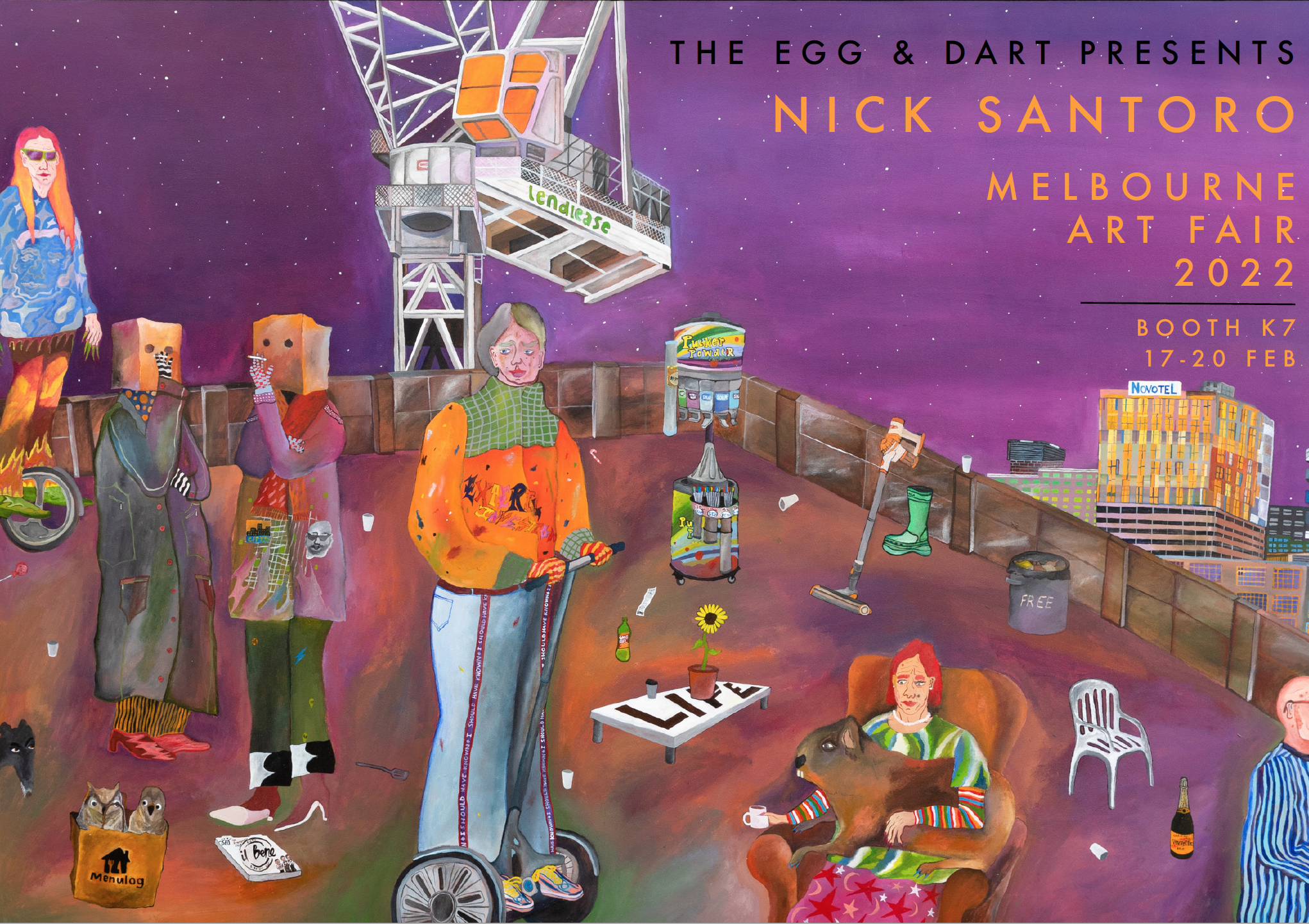
MELBOURNE ART FAIR 2022 | BOOTH K7
The Egg & Dart is excited to bring Nick Santoro to 2022 edition of Melbourne Art Fair. Find us at Booth K7.
Nick Santoro’s work explores an ad hoc parallel between a tangled stream of mediated imagery and the shifting status of things on the street. His absurdist genre paintings offer a populated grab bag where outcasts and winners launch into speculative encounters in an atmospheric dimension between the local and the global. The approach is irreverent while giving symbolic weight to elements like a specific technology, a message on a T-shirt or a brand of shoe. Memory drawing, screenshots from his phone and an awareness of proto-Renaissance composition inform the work. Human figures and animals are elevated through outlines to acquire an aura of celebrity or transcendence. The ground plane lifts up like a stage while glowing skies offer an infinite backdrop.
The painted artist frames establish these paintings as objects that then extend out to include real structural elements like plumbing pipes, cyclone fencing and sculpted hands. The installation proposes a recombinant order to things by piecing together bits of piping as a make-do version of construction. In the other dimension, his drawings strip away colour to develop a richly textural, linear detail. While Santoro’s studio and digital archive offer a collage of reference points and diversions, there are no didactic politics to be found. The work is a data set of pop culture flung up to see what elements find orbit and what then falls back down to earth.
Nick Santoro was a finalist in the Archibald Prize in 2020 with his painting of fellow artist Phanos Proestos. The painting “Hewitts Avenue Montage” was exhibited in the John Sulman Prize in 2019 and his work was presented at Melbourne Art Fair 2020 and Sydney Contemporary in 2019. A significant installation formed part of Here + Now at the Wollongong Art Gallery near the end of 2018 and his work is held in the Wollongong Art Gallery collection. Nick Santoro was born in 1994 and lives in the Illawarra area.
Melody Willis
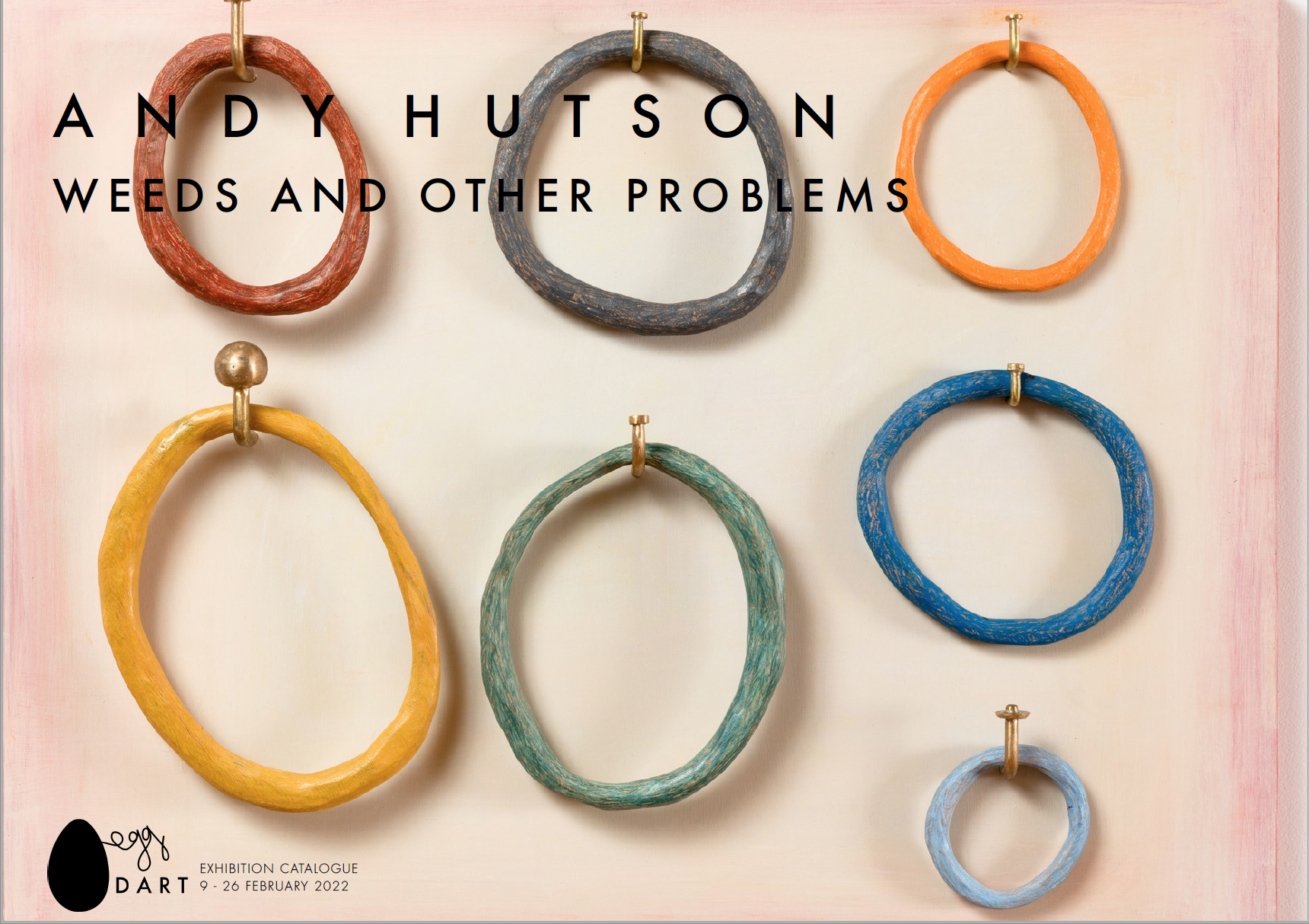
Andy Hutson
Weeds & Other Problems emerged from artist Andy Hutson riding his bike along a disused rail line in nipaluna / Hobart. He noticed the opportunistic growth of plants along the path and their attachment to disturbed soil in a remnant industrial setting. The flexible and opportunistic status of introduced species became a metaphor. Hutson explains that weeds “get in the way and shift the course from an original intent,” in parallel to the way an artwork can come together from an idea but with an unexpected outcome.
“Almost every time along the path there would be some other things that I would notice. It’s still that same process where I have this idea and all these distractions keep shifting my attention. I have a pocket notebook. What you end up with is something quite different from what was anticipated from the outset.”
The artist has a background in sculpture and jewellery making and completed a residency over 2020-2021 at Contemporary Art Tasmania. With an understanding of soldering and braising, this knowledge creeps into the pieces through the handmade brass attachments and the use of sanders and other tools to model the material. The works have pictorial elements, particularly in their connection to the variable qualities of the weeds encountered, their colours and forms. But in being almost-paintings they are also almost-objects, suggesting shelves, mirrors, hinged doors or framing devices. Each work reaches for a satisfying sense of containment and a structural integrity.
The sphere, the ring, ropes under tension and diamond shapes that suggest cyclone fencing – forms repeat and vary in size, scale and definition. The marine rope offers a further link to the specifics of place, namely the nipaluna / Hobart harbour. Fennel seeds are embedded in encaustic. Mallow flowers have been collected from the path, dried and pressed into the surface under wax, before being scraped back to a flat, resilient finish. In another work a bowl is cut and burnt with a heat gun to form a symbolic Oxeye daisy, a common weed in the district.
A Hole in the Fence uses plywood and found timbers including King Billy, an endemic Tasmanian conifer. The wood has been arranged as variable rings on handmade brass hooks and the work feels like an assortment of material origins brought together to propose a harmony. On the hooks hang loops of the various timbers, carved, painted and suspended like a collection of keys that describe negative space. Nosy Neighbour uses Huon Pine, King Billy and Tasmanian oak. Timbers are arranged as a cosmology of white spheres on a black surface. The specifics of material are important with pencil, wax and acrylic binders applied to both push and engage with specialised timber surfaces.
Andy Hutson is thinking about weedy problems and the complexity of states and materials. Plants are wonderful and advantageous but can be a problem in the wrong context. Then there is the problem of making art, of finding the right language. How should things hang or sit as an agglomeration? Hutson describes “trying to find ways to manifest an awareness of place and history associated with plants and land in general, in a practice that is pictorial and visual without being overt.” In his first exhibition at The Egg & Dart, Andy Hutson works with these tensions to find a contemplative and precarious balance.
Melody Willis

